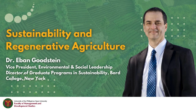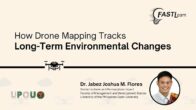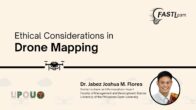Today I want to talk with you about regenerative agriculture a bit. And I want to warn you that I’m not an expert in this particular field, but I want to frame it up as an important dimension of a broader initiative around the transformation of the business world in the direction of sustainability and a powerful metaphor for what’s possible.
As was mentioned, I am the Director of Graduate Programs in Sustainability at Bard College. This is our tagline, change minds, change the rules, change the game, and that’s also an advertisement for my TED Talk, which I did last year. So if you’d like to hear more about kind of the theory of change behind the work we do, please Google me and Google TED Talk and that will pop up.
But briefly, we offer master’s degrees in three areas, and they do relate. So we offer MS degrees in environmental policy and climate science and policy, and those are the change the rules. Like those graduates want to change the rules. They want to get rid of bad laws and regulations and put in place good laws and regulations to drive sustainable outcomes. We have an MED in environmental education.
Those are the change the minds people. They wanna instill in young people a love for the natural world and help them understand the lessons that the natural world can teach us. And then finally, there’s the business side and that’s the MBA in sustainability. And you know, what is business doing in that list of ways to change the world? Well, at the end of the day, no matter how many ways we change through policy and minds we change through education,
Business has ultimately got to figure out how we’re gonna get this done. How are we gonna meet the needs of what are now eight, soon to be nine, likely to be 10 billion people on this one planet where half the people are barely getting by and surviving on less than five or $10 a day. Everybody’s aspiring to more, a better quality of life. We’re fighting over water and clean air and access to fish and forests and biodiversity and it’s getting hotter every year.
So this is a call for business to really radically reimagine what business is doing. And how do we do this? How do we provide the food on the table, lights on, health care in ways that radically, radically cut environmental footprint, but also treat workers and communities and suppliers with justice and with respect, because you can’t have a business that’s ecologically responsible that’s not also socially engaged.
So this is the broader question of sustainable business that regenerative agriculture is situated in. And I will say we’re the number one green MBA in the United States, three years running. We were ranked number two for nonprofit management. And so this kind of work is dear to my heart. So I do wanna just acknowledge the climate change moment in which we’re living.
And it’s accelerating, unfortunately. Last year was the hottest year in human history, recorded human history, even prehistory, so the last 10,000 years, and it was really hot. So this is a diagram that shows that in December of 2023, we were 1.78 C above the pre-industrial.
So, many of you know that the Paris target is 1.5 degrees C. At least for that month, we were well beyond that. We were at 1.8. And look how much hotter it was last December than any other previous record-breaking years. Almost half a degree C warmer. Some people often ask me, well, that doesn’t seem like very much. But I always respond, Bill.
Think about how your body feels when your body temperature goes up by a degree. Right? You’re pretty sick. And if it goes up by two degrees, you’re very sick. And if it stays there, you die. Right? And the unfortunate thing is that natural ecosystems have really evolved with a similar sensitivity to temperature as humans. And as we push the temperature up, one, two, degrees C ecosystems become sick and begin to die. We had the privilege, my wife and I, the last couple of weeks to be diving in the beautiful coral reefs of the Philippines. And they all remain incredibly beautiful at this point, but you can see the symptoms of disease.
You can see the initial beginnings of bleachings and what could come if we don’t get our hands around this. And it’s not just coral reef ecosystems, obviously typhoons, hurricanes, rising sea level, I think you all know that. So this is the moment, and it calls on us to really be ambitious and radical in the way we think about things. So I want to talk a little bit about sustainability. And that conversation always begins with definitions, and I suspect most people are familiar with the original definition of sustainability from 1987.
Meeting the needs of the present without compromising the ability of future generations to meet their own needs So it’s about people and planet and we have a simpler definition that we like at Bard There we go. It comes from a thing called the Meadows Memorandum from about 2018. It’s just shared well-being on a healthy planet shared well-being on a healthy planet captures the social side, the shared well-being side, and it also captures the ecological side, the healthy planet side. And that’s much less of a mouthful. It’s easier to explain to people, so we like that definition. And that leads into kind of a conversation about the idea of a sustainable business.
What is that? So this is my definition.
A sustainable business is an organization that first continually reduces its environmental footprint. And this is something that you’re exploring as you think about using your campus as a laboratory. And also, continuously works to improve the well-being of all stakeholders, meaning employees, customers, investors, suppliers, and communities, then the outcome will be that you are continuously providing more shared well-being on a healthier planet. So a sustainable business is not perfect, but it’s making progress on both the social and ecological dimensions of sustainability. So that’s the way I define a sustainable business, one that is consciously driven in those directions.
There’s always going to be trade-offs. So business is messy. And sometimes there will be step back, backward motion. Sometimes there’ll be trade-offs, and they’ll be doing worse on some environmental front while you’re trying to do better on many environmental fronts. Or there’ll be some stakeholder group whose interests suffer, you know, through a downturn or through some business challenge. So we can’t really ask for perfection from businesses that are trying to do the right thing, but we can ask for progress. But I think we need to keep in mind that this idea of sustainability is an aspiration, and sometimes there are trade-offs.
How do we measure this?
Well, in 2016, the UN provided us a really nice map for thinking about what sustainability would be at the global level or at the national level, not at the business level. And we just taught a course on this, Professor Hollis and Serano and colleagues from half another dozen other schools. And the more I think about this, sorry, the more I think about this particular list of sustainable development goals, the more I recognize that if we actually achieved all those, we would be paradise. We would be living in a utopia. And that’s a good thing. It’s a really nice thing to have a roadmap towards paradise, or a roadmap towards utopia. And one of the things we really work with the students on is to, when they look in the real world and see, well, we’re not making as much progress as we’d like, recognize that, well, this is a two or 300-year project.
We’re not going to get this done overnight, but it’s really good to have a roadmap, and we can begin to evaluate whether we’re making progress or not. Now, on this particular one of climate action, we don’t have 200 or 300 years. We’ve got a couple of dozen, right? So that is the one that I tend to focus on for that reason. If we then go to think about sustainability and practice at the business level, how do we assess whether a business is doing this? Is making continuous progress on the environmental front and the social front? And we’ve actually developed over the last 15, 20 years a tool in the form of sustainability reporting. Here in the Philippines, the SEC I believe requires an annual sustainability report from publicly listed companies.
So companies are beginning to, on an annual basis, produce documents that describe their progress, more or less, in this direction. And this is a good thing. Again, not perfect by any means. I’m sure there’s a lot of greenwashing. So globally, we’re moving towards a more and more systemic approach to this with regulatory frameworks emerging for global companies that are happening in Europe.
California, less so in the US as a whole, that are beginning to sort of create structures, reporting structures around biodiversity impacts, around climate impacts, around greenhouse gas emissions, around water use. So this process of understanding what a sustainable business is, is really beginning to gel. And, at the university level, for example, in the United States there is an organization called STARS, the Sustainability Tracking Assessment and Rating System, where it’s pretty rigorous and schools have to go through a process every two or three years, sort of documenting their progress towards more sustainable operations. So we are making real progress in terms of defining this thing that we call sustainable business.
So that’s gonna take me into a vision for the future about how all this comes together. And the vision for the future that really is the foundation of our MBA program, it’s an MBA in sustainable business, is what I call the sustainable business hypothesis. And that hypothesis is that on average, a well-run sustainable business, one that’s trying to reduce its footprint and trying to treat stakeholders with justice and with respect, over the long run, will outcompete a well-run conventional business that’s just focused on a single bottom line. And over time, sustainable businesses will become the dominant business form on the planet.
Now again, that’s sort of a utopian vision, but there’s reason to believe that this is happening. And the basic idea is that they can do this because strategies that they pursue in pursuit of environmental and social mission can reduce costs, they can increase revenue, or they can accelerate the pace of innovation. All of which are going to make these kinds of businesses more competitive than businesses that are ignoring their environmental impact or ignoring their social impact. So that’s a very hopeful and positive idea. It’s a hypothesis. It’s what my business students are trying to prove out. That’s their job is to go out and see if this really is true in the real world.
There’s a whole list that we talk about in my MBA program of strategies that businesses can pursue that in principle are not just good for the environment or good for stakeholders, but also increase the competitive position of the businesses. And I’m not going to go through this slide. You need to take my MBA program to kind of dig into all of this stuff.
But this is the concrete sort of ways in which we think that sustainable businesses can win, can outcompete conventional businesses. What’s exciting again about this world is that it’s happening in the real world. And this is a sort of new idea in the world of political economy. I mean, traditionally we thought of businesses at best neutral and sometimes bad actors, right, because they pollute and they often exploit workers.
And so the traditional perspective has been that we need government, we need policy to force companies not to do bad things, right? We need to regulate them so they don’t pollute, so they don’t, you know, pay poverty wages. But this is a different perspective, right? It’s saying that through radical business model innovation, it’s possible for businesses to actually do good in the world and do better than exploitative companies.
And so these are all gonna be US-based examples now, going forwards, and I apologize, because that’s the world I come from. So in the 1990s, we had a lot of pioneering companies, some of which you might have heard of, Ben and Jerry’s, I suspect most people have heard of, Patagonia, Clif Bar, and these were companies that were explicitly saying, yeah, let’s try this out. Let’s see if we can do better by doing good to our employees and to the environment.
Then in the 2000s, some big businesses got involved in this. Nike was one of the first because they were called out in the mid to late 1990s in a number of scandals involving child labor in their soccer ball manufacturing.
And, you know, rather than say, oh, try to sweep this under the rug and pretend it was somebody else’s problem, they made a corporate commitment to say, no, we’re going to solve this. We’re not going to have child labor in our soccer ball factories, even though we don’t own them, somebody else does. We’re going to be responsible for our supply chains. And that was a really big sort of watershed change in the way that global multinational corporations were operating.
We had companies like Unilever under Paul Pullman adopt a sustainable living plan, this is a massive global conglomerate that produces soap and beauty products. And really said we’re going to focus on solving some of the world’s biggest problems through the you know, through our production of soap and other products. And they began to re-frame kind of their corporate strategy around that. Walmart has become a big player in this in terms of versing better practices in their supply chain. You know, basically saying if you want to sell to Walmart, you’ve got to meet certain environmental standards.
And again, I don’t want to pretend like these companies have no flaws. Many of them still have problems, but they are making sort of big strides independent of any regulatory requirements in changing the environmental, in particular the environmental impacts of their supply chains. So, and then in general during the 2000s and 2010s, CEOs around the world began to talk a lot about purpose and mission because they realized that employees didn’t want to show up in order to make profits for shareholders. Wasn’t very inspirational. And so they began to think, what is the real social mission of my company? What is the real environmental mission of my company? Again, greenwashing was a possibility, but it really was a sea change.
I think it’s common within the boardrooms of large companies now to talk about sustainability, to talk about mission sort of independent of how much money it’s going to make for stockholders. So this idea has really taken root in a powerful way and that’s good news. We had an explosion in investing on the financial side in companies that are doing this.
So investors began to look for companies that had better environmental, social, and governance performance. Again, in line with that hypothesis, they’re thinking that if companies are actually spending more money on these things, they’re actually gonna make more money in the long run. And so that was significant. There’s now trillions of dollars on the management that has some kind of focus on environmental, social, and governance factors.
And then finally, in the last couple of years, we’ve had many, many companies, almost a thousand of the biggest, 2,000 biggest companies in the world, commit to ambitious climate goals, net zero goals. Again, independent of any regulatory framework, right? These are just companies making these commitments. Again, greenwashing, some of them are backpedaling, some of them are non-committing, but still.
Very impressive, right? Inconsistent with this sustainable business hypothesis. So that is the backdrop for thinking now about the idea of regenerative business. And I’m going to use regenerative agriculture as my model for regenerative business. So we talked about sustainable businesses sort of as businesses that are doing less bad.
They’re continually doing less bad. They’re less pollution, less exploitation. Regenerative is gonna flip that and say, well, what could we have a company that was net positive, that was actually doing good in the world, in a real positive way? So I’m gonna define it this way. An organization, that in producing a good or service, also enriches all forms of capital used to produce the good or service. And that’s the natural capital, the resources, resource base that it’s utilizing, the social capital, the strength of the community in which it’s operating, the human capital.
That’s the sort of capabilities of their employees and future employees. And then financial capital. So it has to be a profitable organization. It’s gotta generate more financial income than it uses up, right, in order for it to be sustainable, regenerative. So, yeah, again, just a reminder that what it means to regenerate financial capital means it’s profitable.
Again, in the real world we need to recognize trade-offs. For example, any use of a non-renewable, non-recyclable resource is by definition extractive and not regenerative. And there’s no company in the world that doesn’t use some of these resources, right? So there’s never gonna be a perfectly regenerative company
There will be ones that are more or less regenerative based on an evaluation of these different forms of capital. So what does this mean in the real world? And the place where this really is tangible and is easy to see is in regenerative agriculture.
It’s the industry where I think the term first took root and is, I think, most powerfully illustrated. And when you talk about regenerative agriculture, you’ll always get pictures like this with this is the soil after it’s been regenerated, and this is the soil that’s been destroyed through conventional agriculture. So it’s very visual, or you’ll get pictures like this with this is the regenerative agricultural techniques on the right and the conventional techniques on the left. So it’s cover cropping and no-till agriculture. And so it’s a very compelling story metaphor in the sense that we’ve got these nice visuals. And it’s, in the case of agriculture, potentially very important for climate. And it’s sort of, just to give you a sense of the scale, lots of estimates all over the place on this, but if we were to transform all existing cropland in the world, over to regenerative forms of agriculture.
Scientists estimate we could store something like three to seven years of human CO2 emissions of carbon in the soil. Some people go much higher than that, but that’s sort of a middle range estimate. And that’s important. That’s a big chunk of carbon that would bias, you know, maybe a quarter degree C or something like that, which for the younger people in this audience is gonna be very important. So it’s potentially very important from a climate perspective.
So I’ll just tell you a couple of stories about this in a US case. So there’s a very good book what we call commodity agriculture in the United States. So 150 acre farms are bigger, well what would be at hectares, I guess 60 or 70 hectare farms that are producing corn, wheat, soy. And Gabe Brown was a conventional farmer who was growing broke, losing lots of money, trying to compete in this sort of highly competitive commodity agricultural markets and made a transition to really, because we’re the pioneers, and sort of had to figure out what regenerative agriculture meant in the context of that kind of commodity agricultural production. And then on the right, we’re talking about a small, maybe two hectare vegetable farm in New York.
So, Gabe’s farm is here in North Dakota, the Sofow Farm is here in New York. And that’s a farm that’s really thinking about community and human capital regeneration, as much as it is thinking about regeneration of the soil because this is a farm that was founded by primarily African American and indigenous Americans with a specific project in mind which was to train people from those communities to re-engage with agriculture and re-engage with the land.
For those of you who know American history, most African Americans were farmers after slavery ended. And so 80, 100 years ago, something like 15% of American farmers were African-American. Then they had their lands stolen from them in a variety of ways. And now it’s 1% or less or something like that. So this is a group committee that’s trying to recapture sort of historical engagement with agriculture from the African-American community and indigenous communities.
And also, think about the food system and how do we support low income communities to gain access to healthy food. So it’s not just about the soil, capturing garbage in the soil, it’s really about how do we create truly regenerative agricultural systems that have farms and communities that are made richer and regenerated through this business process.
So, you know, Gabe’s work in sort of large scale command agriculture is also about community, but maybe a little less so, because it’s more about the farming techniques that are used in large scale agriculture. So what does it look like, you know?
In the US context, there’s a bunch of practices that characterize regenerative agriculture around the natural capital piece, the soil piece. Noer or lotel agriculture, diversity of plants and animals on the land to improve soil and ecosystem health, provide defense against pests and diseases, keep the soil covered,
So cover cropping year round. Maintain a living root system year round. So again, no deep tilling of the soil. And integrate grazing animals, livestock, as a way to improve soil health. And interestingly enough, this comes from the website of a very large corporation, the General Mills Corporation.
And I’m going to talk in a minute about the ways in which large corporations in the United States have really gotten engaged with this idea of regenerative agriculture in terms of just the natural capital piece. They’re not thinking too much about the other two. But we need to think about that. So on the financial side, it’s about firm profitability.
And for Gabe Brown, this was an avenue for him to actually achieve profitability and, you know, regeneration of financial capital for his family and his business. So we talked about farm profitability, but we haven’t talked much about how regenerative agriculture, at least at this scale, is really affecting workers, farm communities and those are important metrics that we would want to engage with. If you go back to the previous slide, you’ll see that the Soil Fire Farm, in addition to that list of techniques that I discussed, they were also focused on some other techniques, raised bed production and polycultures. And this is really drawing from kind of ancestral knowledge and indigenous knowledge as a way to inform the production, which is about soil health, but it’s also about community health, because it creates relationships among people. And local business building materials.
Again, feeding community, food sovereignty, these are things that are emphasized at this kind of local and more indigenous sort of approach to regenerative agriculture that you won’t see so much when General Mills is talking about regenerative agriculture. But they are. And so, really a lot of activity in terms of corporations, again, deciding they wanna do this. So General Mills is advancing regenerative agriculture on a million acres of farmland by 2030 in support of their net zero commitment So basically they want to take credit for all the carbon in the soil that they’re forcing their upstream farmers to to to Sequestor right through this regenerative agricultural techniques Unilever 10 million acres of land regenerative agricultural principles
Cargo paying farmers per metric ton of carbon sequestered through regenerative farming techniques 10 million acres again by 2030 To meet a 30% by 2030 greenhouse gas reduction target across the value chain. So that’s that net zero commitment again Is is being met partially through? Working with their suppliers to reduce emissions
Pepsi, again, seven million acres by 2030. And then Amazon, actually working in the actual Amazon, on 5,000 acres of agroforestry projects on degraded land with plant fruit-bearing trees. So, you know, what is the motivation for these companies to adopt these regenerative techniques? Well, actually it’s the net zero commitments that they have said they’re going to cut emissions and this is a way they see doing it is by sequestering a lot of carbon in the soil through these regenerative agricultural techniques. Part of it is that they are just looking to build more resilient supply chains.
And so they want those farmers to continue to be productive in the face of climate change and so they want healthier soils in their supply chain. And so they’re working with those farmers to create the conditions to really have a sustainable supply chain. And part of it, you know, that’s kind of a risk reduction strategy, I think. So they are really looking, they see this as not charity. I mean, they really see this as good business practice and adopting these regenerative agricultural techniques.
Now again, it’s really only on that one dimension probably. Maybe financial profitability for the farmers might improve as well. But it’s really about the natural capital, not so much the human capital and the social capital. Okay, so let me circle back to this question of, this is a really interesting case study. Is it a metaphor for something bigger? Can we think of a regenerative university?
Or can we think of a regenerative producer of cell phones? Or a regenerative producer of solar panels? And it would be nice if we could, because we might go from a less bad to a net positive perspective, right? So, I’m not sure we can get there though, because really we don’t have a good measurement frame.
We do, we’re developing tools for measuring a more or less sustainable businesses in terms of carbon footprint, water footprint, human rights, best practices, fair wages, all of those things. So we can begin to, through ESG measures, sort of figure out whether a company is sustainable. But I think it’s gonna be much harder to measure whether it’s regenerative. You know, what is the equivalent for soil health for other sectors?
where we don’t have that nice visual of before and after natural capital. How do we measure regeneration of human and social capital in addition to natural and financial capital? So these are the challenges of thinking about regenerative business more broadly framed. But I think it’s interesting and powerful and something that we probably should do.
because it does have a powerful potential for thinking about how to get to utopia faster if we’ve got that mindset. So that’s what I wanna talk about today. We’re barred, this is what we do. And thank you for having me here. I hope it wasn’t false advertising. We didn’t go deep into regenerative agriculture, but glad to answer any questions about this.

























